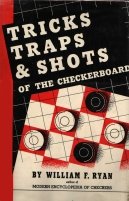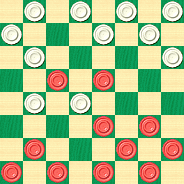The Checker Maven
Jump to navigationA Bristol Broadside
The word "broadside" carries various meanings, and perhaps the one that comes to mind at first is the "broadside" fired by the cannons on warships of a bygone day. Cannons were arranged on the sides of the ship, and having all of them fire a more or less simultaneous volley made for a powerful attack.
But there's another meaning. British photographer Stephen Dowle notes that advertising on the side and front of a bus, as illustrated above, is often called a "broadside"; hence, the photo is titled "Bristol Broadside."
Our presentation of Willie Ryan's Tricks Traps & Shots of the Checkerboard continues with an exposition on the 11-16 Bristol opening, presented in four parts due to its length. To say that this first part is explosive and spectacular is almost an understatement. Certainly Willie was thinking of cannons and not buses.
Here's Willie's run-up and notes. Additional variations will appear in future columns.

| 11-16 | 26-23---H | 9-13 | 16-11 | 14-17 |
| 24-20 | 19-26 | 22-18 | 6-10 | 32-27 |
| 16-19 | 30-7 | 14-23 | 11-7 | 17-22 |
| 23-16 | 2-18 | 27-18 | 22-25 | 27-23 |
| 12-19 | 28-24 | 13-17 | 7-2 | 25-30; |
| 22-18 | 9-14 | 21-14 | 1-5 | drawn. |
| 10-14---A | 24-19 | 8-11 | 2-6 | Campbell |
| 18-15---B | 5-9 | 16-7 | 10-14 | vs. Reid |
| 7-10---E,1 | 25-22 | 3-17 | 18-9 | |
| 20-16---F,2 | 18-25 | 19-16 | 5-14 | |
| 14-18---G,3 | 29-22 | 17-22 | 6-10 |
A---"The text was a long-standing favorite with that renowned celebrity of the draughts world, James Wyllie. It was also popular with many other stars of the Andersonian firmament. Although it has gained only negligible favor with the modern exponents of the go-as-you-please school, one is certain to regard the line with increasing respect as its ramifications are mastered.
B---In a title game between two world's champions, Richard Jordan and James Ferrie, the former attempted 27-23 here. The game proceeded 8-12, 23-16, 12-19, 18-15, 4-8, 25-22, 9-13, 32-27, 5-9, 29-25---C, 7-11, 27-24,11-18, 24-15---D, 2-7, 20-16, 7-11, 16-7, 3-19, 22-15, 14-18, 26-23, 18-27, 31-24, 9-14, 24-20, 14-18, 20-16, 8-12, 16-11, 19-23, 11-7, 23-27, 7-3 (30-26, 27-31, 26-22 should develop a draw), 27-31, 28-24, 31-27, 24-20, 18-23, 15-11, 6-10, 3-7, 12-16, 7-14, 23-26, 30-23, 27-9, 11-7, 16-19, 7-3, 9-14, 3-7, 14-18, and Ferrie won. Considering the usually high caliber of Mr. Jordan's play, this one stands out on the record as one of his worst examples. Time and again he displayed a remarkably dull grasp of the involved positional structures.
C---15-11, 8-15, 27-23, 1-5, 23-16, 14-17, 21-14, 9-25, 29-22, 7-11, 16-7, 2-11, 30-25, 6-10, 25-21, 5-9, 22-17, etc. would be a much easier way for white to play for the draw. Wm. F. Ryan.
D---This seems to be about the spot where the Great Jordan fell into error. A draw after 24-15 is difficult to reach. The alternative jump gains the draw easily with: 22-15, 3-7*, 20-16, 7-11, 16-7, 2-18, 24-15, 6-10*, 15-6, 1-10, 28-24*, 8-11 (10-15, 31-27, 8-11, 26-23), 24-19*, 18-22, 25-18, 14-23, 19-16, etc. Wm. F. Ryan.
E---The line of play initiated at A is usually associated with this follow-up, although black can safely adopt other moves, as depicted in Variation 1. The student should bear in mind that the strategical advantage in adopting a dormant line of play, such as the one begun at A, is twofold: first, it may throw the adversary off lines of play he is most likely to know; second, it gains the initiative and efficiency that go with employing a well-prepared plan of attack. It has been proved time and again that a player who takes a weak line of play and knows it thoroughly will win more games than the one who adopts a standard procedure of play without knowing how to carry it through.
F---To the player handling the white pieces, this is an important waiting move, as it simplifies the formational structure by thwarting any attempt by black to secure tenable complications. See Variation 2 for 25-22 here.
G---Just about all that black has left. For play on 9-13, see Variation 3. Alfred Jordan tried 2-7 here in a title match duel with Melvin Pomeroy and finished on the rocks by 16-12, 14-18, 21-17*, 9-14, 17-13, 5-9, 27-24, 7-11, 26-22, 19-23, 31-27, 10-19, 24-15, 14-17, 27-24, 17-26, 15-10, 6-15, 13-6, 1-10, 32-27, 23-32, 30-7, 3-10, 12-3, 11-16, 24-20, 16-19, 3-7, 10-14, 25-22, 14-18, 7-11, 18-25, 29-22, 19-23, 11-27, 32-23, 28-24, 23-26, 22-18, 26-23, 18-14, 23-18, 14-10, 4-8, 10-7, 18-15, 7-3, 8-12, 3-8, 15-18, 24-19; white wins.
H---White must accept the clearance or drift into a ragged formation. If 27-24 is played, then black wins with:" (See solution---Ed.)
1,2,3---To be presented in subsequent Tricks Traps & Shots installments---Ed.

BLACK
Black to Play and Win
B:W32,31,30,29,28,26,25,24,21,16,15:B19,18,10,9,8,6,5,4,3,2,1.
The computer rates this one as a strong Black advantage and a probable win, but it's not so easy. Fire away at it; give it your best volley, and when you've done your best, click on Read More to see both Willie's solution and the computer's notes.![]()
Solution
H---(cont.) "9-14, 24-20, 5-9, 16-11, 9-13, 32-27---E1, 6-9, 15-6, 8-15, 20-16, 1-10, 27-24, 18-23, 25-22 (24-20, 14-18, 16-11, 18-22, etc., white wins), 23-27, 30-25, 27-32, 22-17, 13-22, 25-11, 10-15, 24-20, 14-18, 16-12---E2, 18-23, 26-22, 9-13, 31-27, 23-26, 27-23, 26-30, 23-16, 32-27, 21-17, 30-26, 29-25, 27-23---E3. A. J. Hefner."
E1---11-7 actually loses more slowly according to the computer, though probably no one would play it in practice---Ed.
E2---21-17 is better---Ed.
E3---White, a piece up, still loses after 25-21 23-19 and White has no moves left, for instance 22-18 15-22 17-14 19-15 21-17 15-8 14-10 22-25 17-14 2-6! 10-1 8-11 16-7 3-17 and on to a routine Black win---Ed..
This was an interesting study in material advantage vs. mobility and positional advantage. Being a piece up is not a guaranteed win. There are often resources and subtleties in the position that, to a skilled player, change everything.
You can email the Webmaster with comments on this article.

